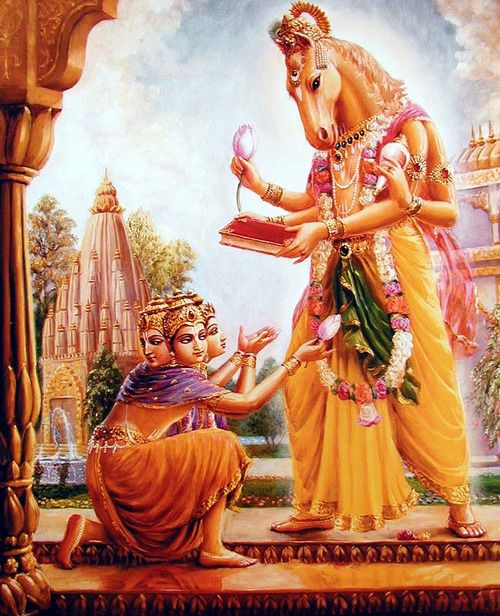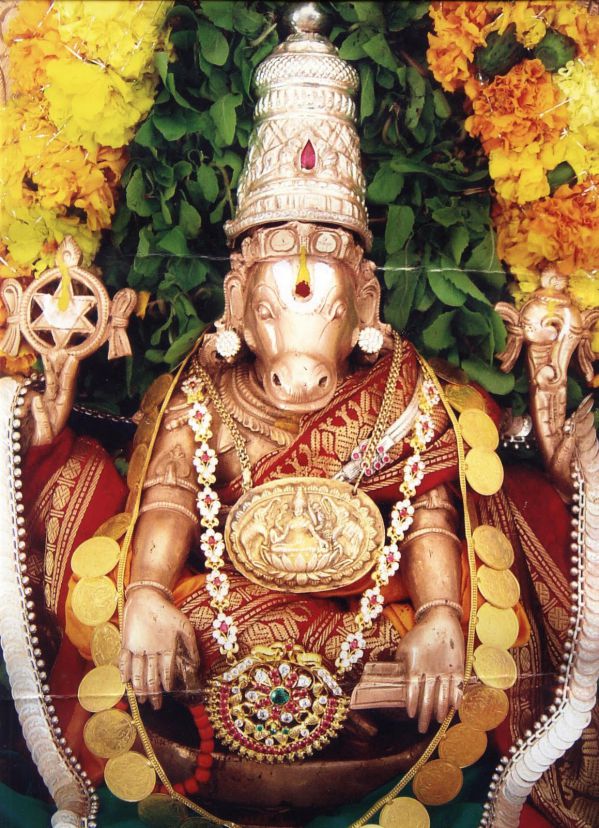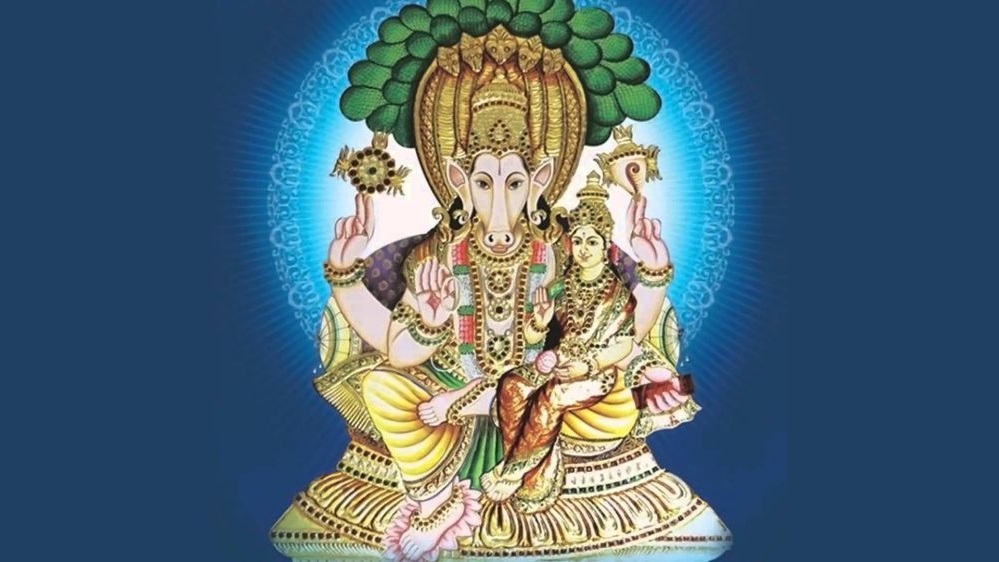No products in the cart.
In Hinduism, Hayagriva or Hayagreeva is also considered an Avatar of Lord Vishnu. He is worshiped as the God of knowledge and wisdom, with a human body and a horse’s head, brilliant white in color, with white garments and seated on a white lotus. Symbolically, the story represents the triumph of pure knowledge, guided by the hand of God, over the demonic forces of passion and darkness.
There are several stories about this unique avatar of Lord Vishnu.
One of the versions is that Vishnu revealed the Vedas to Brahma at the time of creation. Realizing the power of these Vedas, two demons Madhu and Kaitabha stole the Vedas from Brahma and hid them at the bottom of the ocean. When Brahma sought Vishnu’s help to retrieve the sacred texts, Vishnu took the Hayagreeva form, killed the two demons and returned the Vedas to Brahma.
Another very interesting version is found in Devi Bhagawat Purana .A demon named Hayagriva (one with the face of a horse), son of Kashyapa Prajapati, performed severe penance and obtained a boon from Goddess Durga, that he could be killed only by another “Hayagriva” and none other. Having got this boon, he grew arrogant and started creating havoc in Devaloka. The hapless Devas, as usual, turned to Vishnu for deliverance from the evil and cruel demon. But the boon proved too powerful even to Vishnu as it was given by none other than the Supreme Goddess.
Even after a prolonged and fierce battle, the demon Hayagriva remained invincible. But the battle took its toll on Vishnu. He proceeded to Vaikuntha to recuperate and replenish His power and strength. It is said that He sat in Padmasana with His head resting on the upper end of His taut bow and got engrossed in deep meditation (Yoganidra).
The Devas wanted Him to resume the battle but none could arouse Vishnu from His yoganidra. So, Brahma thought of a plan. He created termites that would gnaw at the bowstring and when the string broke, the resonant sound created, would surely wake up the Lord.
The string snapped with the tremendous sound that reverberated through the entire universe, but because of the force with which it snapped, Vishnu’s head got severed from His body and fell into Lavan Sagar .Brahma’s plan had backfired and resulted in total disaster. The Devas were distressed and dismayed at the calamity. Their only hope now, was to invoke the Mother Goddess. She had always protected them in times of dire need, time and again. So they prayed to Her and sought Her gracious help. Pleased with their prayers She assured them that there was a divine purpose behind this incident. Vishnu would get His form back once this purpose was achieved.

She instructed them to attach the head of a horse to Vishnu’s neck, who would then become a “Hayagriva” and therefore in a position to slay the demon. Accordingly, Brahma attached the head of a white horse To Vishnu’s body and the revived Vishnu destroyed the demon. Later He resumed His usual form. The incarnation, Hayagriva, however, came to be worshiped and revered as very personification of all knowledge (Jnananandmayam devam), speech, vidya(education)- of all types (adharma sarva vidyanam) —- a victory, of brightness of wisdom over darkness of ignorance and the supremacy of the divine over the demoniac.
Hayagrīva is a very important deity in the Vaishnava tradition. His blessings are sought when beginning study of both sacred and secular subjects. Special worship is conducted on the day of the full moon in August (Śravaṇa-Paurṇamī) (his avatāra-dina) and on Mahanavami, the ninth day of the festival. He is also hailed as “Hayashirasa”. Hayaśirṣa means haya=Horse, śhiraṣa=Head.
In IAST
Jñānānanda mayaṃ devam nirmala sphaṭikākṛtiṃ
Ādhāraṃ sarvavidyānaṃ hayagrīvaṃ upāsmahe
In Devanāgarī
ज्ञानानन्द मयं देवं निर्मल स्फटिकाकृतिं
आधारं सर्वविद्यानं हयग्रीवं उपास्महे
This verse is originally from the Pañcarātra Agamas but is now popularly prefixed to the Hayagrīva Stotram of the 13th century poet-philosopher Vedanta desika. It is very popular among devotees of Hayagrīva.
Vedanta desika’s dhyāna-śloka (meditative verse) on Hayagrīva typifies this deity’s depiction in Hindu iconography:
He has four lotus hands, with one in the mode of bestowing knowledge another holds books of wisdom, and the other two hold the Conch and Discus. His beauty, like fresh cut crystal, is an auspicious brilliance that never decays. May this Lord of speech who showers such cooling rays of grace on me be forever manifest in my heart! In the Mahāvairocana-sūtra [Sutra of the Great Sun] translated and copied in 1796 by I-hsing it says: “Beneath the buddhas is Hayagrīva. His body is the color of the sun at dawn. He wears flaming effulgence and skulls as a garland. His nails are long and sharp; his face shows a pair of bare tiger’s fangs. His hair is that of a burning lion’s mane. He is awesomely powerful and fierce! This is the fierce Vidyaraja [wrathful vehicle] of the Lotus section. He is just like a horse-jewel of a Chakravarti that wanders the four continents, nowhere and never does he rest, having all the great and terrible force of all the Buddhas’. This is his nature, and therefore he possesses this terrible and all-mighty light. Amidst the greatest obstacles of death and evil he is without the slightest care for his own welfare, his conspicuous and uncommon gallantry, intrepidity, and wrath is legendary among the gods, and therefore he easily and quickly vanquishes all who oppose him! Many others submit to him at first sight! This is because though he is fierce and terrible; his heart is full of compassion (unbiased, dispassionate understanding).” — Hayagrīva Stotram, v.32
 Later on Hayagriva is referred to as the “Horse necked one”, Defender of faith”, the “Terrible executioner”, the “Excellent Horse”, and the “Aerial horse”.
Later on Hayagriva is referred to as the “Horse necked one”, Defender of faith”, the “Terrible executioner”, the “Excellent Horse”, and the “Aerial horse”.
This said, the Horse god is seen as pulling the sun up to the heavens every day, bringing light to darkness. Marici represents the essence of the power of creation of the cosmos. Hayagriva represents the manifestation of yin/in as the power and action of the cosmos manifested as action. This is the very definition of Tantra, that of action.
In several other sources he is a white horse who pulls the sun into the sky every morning. In others such as the great epic Taraka-battle where the gods are fallen on and attacked by the Danav’s [demons], Vishnu appears as great ferocious warrior called Hayagriva when he comes to their aid. It says;
“Hayagriva appears in his chariot, drawn by 1,000 powerful steeds, crushing the enemies of the gods beneath him!”
There are many other references to Hayagriva throughout the Mahabharata. It is said that Vishnu comes from battle as a conqueror in the magnificent mystic from of the great and terrible Hayagriva;
“The great Hayagriva having been praised in this way by the different saints and ascetics, assumes a great white horses head. The verda’s [mantras] made up his shape, his body built of all the great gods; in the middle of his head was Shiva, in his heart was Brahma, god of heaven; the rays of sun were his mane, the sun and moon his eyes; the Vashu’s and Sādhya’s were his legs, in all his bones were the gods. Agni was his tongue, the goddess Saraswati his speech, while his knees were formed by the maruts and varuna. Having assumed this form, an awesome wonder to behold to the gods, he vanquished the asura, and cast them down, with eyes that were red with anger.”
Invariably, Hayagriva is depicted seated, most often with his right hand either blessing the supplicant or in the Vyakhya mudra pose of teaching. The right hand also usually holds an aksha-maalaa (rosary), indicating his identification with meditative knowledge. His left holds a book, indicating his role as a teacher. His face is always serene and peaceful, if not smiling. Unlike his Buddhist counterpart, there is no hint of a fearsome side in the Hindu description of this deity. Indeed, the two deities seem to be totally unrelated to one another.
Hayagriva is sometimes worshiped in a solitary pose of meditation, as in the Shri Krishna mutt temple of sode paryaya.






